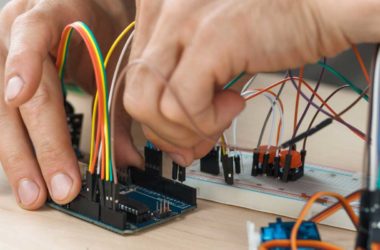Though, so far, it has generally been larger organizations that have implemented automation, it should not be considered exclusive to them. Small and medium-sized enterprises (SMEs) can equally gain from introducing automation in their factories and workshops. After all, industrial robots ensure greater productivity and eventually lead to higher profitability – and these are of importance to businesses of any size.
The problem is that most SMEs still find such robots prohibitively expensive to buy. Additionally, setting up, programming and maintaining conventional robots involves a significant learning curve, and this results in yet more expense. Even if they overshoot their budgets to purchase a complex industrial robotic arm, most firms end up only using a fraction of its actual features. Consequently, smaller companies will generally still be over-reliant on human labor, despite the proven advantages of using intelligent robotic machinery.

Affordable Robots for All
Though SMEs have, until now, been overlooked by robotics manufacturers, this is starting to change. Fortunately, some have started to see how big a prospect the SME sector could be – and are coming up with innovative technologies to bring down the price tag of industrial robots. One such robotics start-up is Automata. This UK-based company has developed the EVA robotic arm, which is now seeing widespread commercial uptake. Before looking at this and other options that are currently available in greater detail, let’s first define what the requirements of SMEs will be.
Technical Considerations for Economical Robotics
The core aspects that need addressing if a robot arm is to be effective in an SME context are as follows:
- Compact Design: Small companies usually do not have large workspaces or shop floors. With space at a premium, their robots should be optimally designed to take up only minimal footprint.
- Energy Efficiency: SMEs should factor in the power consumption of their robotic platforms, as this could otherwise prove to be a heavy operational expense. Smaller robots generally consume less power and will result in a lower total cost of ownership (TCO) over time.
- Safety: Conventional industrial robots, with powerful arms, can put workers at risk if precautionary measures are not followed. However, smaller, affordable robots are designed with a wider array of safety features incorporated – as they will need to collaborate with humans in close contact.
- The Learning Aspect: A lengthy training path for employees can offset any cost advantages of an affordable robot. Businesses should therefore consider choosing a simple-to-operate platform.
- Maintenance: Preventive maintenance, replacement of items prone to wear-and-tear, as well as batteries and refurbishment, should not be overlooked. These must also be added to the TCO relating to the selected industrial robot model.
- Compatibility: SMEs must make sure that their affordable robot can be used across a large number of processes. Again, an ideal robotic arm should be compatible with various software or hardware tools to make it versatile enough to attend to multiple tasks. This will make it easier to get a return on the investment made.

About EVA
Automata’s EVA is a flexible, 6-axis industrial robot that is straightforward to integrate into various laboratory and workshop environments. This is allowing such operations to enhance their workflows, without requiring heavy financial outlay. As well as EVA being affordably priced, it is simple for staff to work with, so only minimal training is required.
This robot arm weighs less than 10kg and can move a payload of up to 1.25kg. It has a reach of 600mm. EVA is also AI capable, which makes it suitable not just for performing routine tasks (like pick-and-place of component parts), but also for critical jobs, such as quality control and sorting. It has been deployed for screening in several drug discovery labs and nucleic acid testing within diagnostics labs.
ST Robotics is another company that manufactures low-cost robots, especially collaborative industrial robot arms. NASA, IBM and Boeing are among its clients. Its R17 is a 5 or optionally 6-axis articulated robot arm. With its long reach, this arm is intended for operations that involve difficult access (such as testing, spraying and welding). The R17 comes in higher speed and heavier payload versions. It has a plug-and-play set-up with the controller, cables and project management software all part of the package.
Future of Automation and Affordable Robots
The post-pandemic world and growing adoption of Industry 4.0 (or even Industry 5.0) are expected to drive further demand for industrial robots. SMEs looking to remain innovative and differentiate themselves from their competition will certainly need robots in their production facilities and research labs.
With more computing power and the ever-decreasing size of electronics hardware, the barriers to entry in relation to robots will subside. Consequently, affordable robotic solutions are destined to become increasingly accessible to companies – no matter what their size, and regardless of their budget constraints.
Of course, there are costs beyond just buying the robot itself, and SMEs need to be fully aware of these. If this is done correctly, however, then the numerous benefits of robotic automation can be realized and the investment fully justified.
Product Options
In addition to offering EVA robot arms, Distrelec has a wide variety of other robotic solutions in its portfolio – and these can help customers to attain their automation objectives.
Among the highlights here are the uArm Swift Pro robotic arm, which offers an entry-level DIY solution based on open source Arduino technology. Programming is simple, and can be done via Python. This robot arm is highly suited to hobbyists, as well as being of use in the educational domain. There is also the KSR10 robotic arm kit from Velleman, which is intended for integration into maker projects or potentially for the prototyping of larger scale systems.












